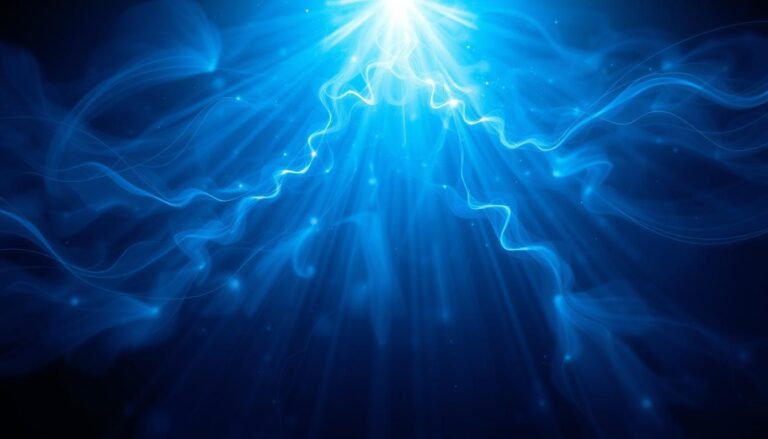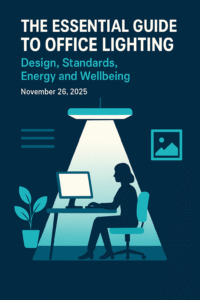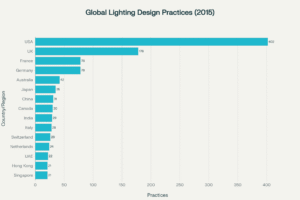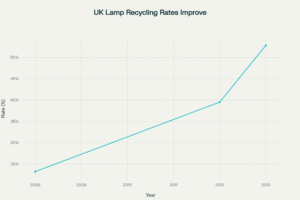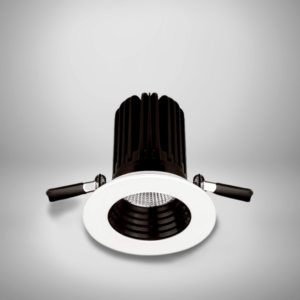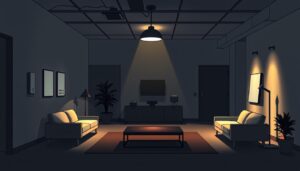Did you know the sun’s blue light is up to 1000 times stronger than what electronic devices produce? This fact underlines the critical role blue light plays in our lives, with the sun being the primary source. Blue light, spanning 400-500 nanometres in the electromagnetic spectrum, is everywhere. It comes from both natural and artificial sources.
Exploring blue light reveals its significant impact on our health. It can disrupt sleep and even cause skin ageing. In this article, we’ll uncover 10 surprising facts about blue light. This knowledge will help you understand and manage its effects on your wellbeing.
Understanding the Science Behind Blue Light
Blue light, with wavelengths between 400 and 500 nanometres (nm), is a key part of the visible light spectrum. It has a higher energy content than other visible colours. The sun is the most powerful natural source of blue light, emitting light up to 1000 times stronger than electronic devices. Modern artificial sources, such as LED lights and digital screens, have significantly increased our daily exposure to blue light.
The Electromagnetic Spectrum and Visible Light
The visible light spectrum spans from red to violet, with blue light between 400 and 490 nm. It is part of the broader electromagnetic spectrum, which also includes infrared, ultraviolet, and X-rays. The human eye can only perceive the visible light spectrum, including blue light.
Wavelength Range and Characteristics
Blue light wavelengths range from 400 to 490 nm. Most of the blue light we encounter daily comes from artificial sources like LED lights and digital screens. Research indicates that short-wave blue light, between 415 and 455 nm, may harm the eyes and contribute to age-related macular degeneration.
Natural vs. Artificial Sources
The sun is the primary natural source of blue light, emitting it as part of the full spectrum of visible light. Yet, the rise of artificial lighting and digital technologies has greatly increased our exposure to blue light from man-made sources. It’s vital to understand the differences between natural and artificial blue light sources to manage their health impacts.

The Surprising Connection Between Blue Light and Your Sleep Cycle
Blue light exposure significantly impacts our sleep-wake cycle by suppressing melatonin secretion. This is a key regulator of our circadian rhythm. While beneficial during the daytime for alertness, blue light from digital devices at night can disrupt sleep patterns. This effect on melatonin production explains why excessive screen time before bedtime may lead to sleep disturbances and altered sleep quality.
Recent research shows that a two-hour exposure to blue light (460 nm) in the evening suppresses melatonin. The shortest wavelengths (424 nm, violet) have the maximum suppressive effect. Interestingly, even the longest wavelengths (631 nm, red) and intermittent light exposure induce circadian resetting responses. This suggests that our biological clocks are highly sensitive to light cues.
The melatonin concentration recovers rapidly within 15 minutes after exposure cessation. This indicates a short-term impact on melatonin secretion. Age was found to reduce melatonin secretion and suppression. But, it does not affect the circadian phase advance induced by light exposure.
| Findings | Details |
|---|---|
| Melatonin Secretion and Light Exposure |
|
| Sample Size and Detailed Light Exposure |
|
| Circadian Rhythm and Light Exposure |
|
Researchers have also explored the role of blue light in disrupting the circadian rhythm at the molecular level. A study published in the journal Nature has focused on investigating the circadian rhythm photosensor and its target in fruit flies. This aims to understand the role of blue light in sleep-wake patterns. The findings suggest that blue light exposure impacts the protein TIM, preventing it from turning off genes. This disrupts the circadian rhythm.
“Discoveries such as a ‘groove’ in the TIM protein shed light on how it interacts with human proteins and influences sleep patterns.”
These insights highlight the importance of managing blue light exposure, specially in the evening, to regulate circadian cycles and improve sleep quality. Recommendations include using blue light glasses, blue-free lighting, and red light therapy. These methods help mitigate the disruptive effects of blue light on melatonin suppression and circadian rhythm.
Common Sources of Blue Light in Daily Life
Blue light, a key part of the visible spectrum, is everywhere in our daily routines. It comes from digital devices and modern lighting systems, affecting our exposure levels. Knowing where blue light comes from is key to managing its risks.
Digital Device Emissions
Digital devices like smartphones, tablets, computers, and TVs are major sources of artificial blue light. Their LED and LCD screens emit a lot of blue light, which can mess with our natural sleep cycles. This can cause eye strain, headaches, and sleep problems. Studies show most Americans use electronic devices close to bedtime, affecting their sleep quality.
Environmental Sources
The sun is the biggest natural source of blue light. Sunlight, full of visible light including blue, has both good and bad effects on health. In the day, blue light boosts performance and attention, helping our sleep at night. But, blue light before bed can stop melatonin release, messing with our sleep cycles.
Modern Lighting Systems
Modern lighting, like LED and fluorescent bulbs, also emits a lot of blue light. These lights are common in homes, offices, and public areas, increasing our blue light exposure. Long-term exposure to blue light can harm our health, leading to metabolic and mental health issues.
| Source | Blue Light Emission | Potential Health Impacts |
|---|---|---|
| Digital Devices | High | Sleep disturbances, eye strain, headaches |
| Sunlight | Moderate to High | Positive (daytime), negative (night-time) effects on circadian rhythms |
| LED and Fluorescent Lighting | High | Circadian rhythm disruption, negative health impacts |
Knowing where blue light comes from is the first step to managing our exposure. By being aware and taking steps to reduce it, we can improve our health and well-being.
Blue Light and Its Impact on Skin Health
Recent studies have revealed the surprising effects of blue light on skin health. It’s not just UV radiation that harms our skin; blue light, a high-energy visible light, is also a significant threat.
Blue light can lead to hyperpigmentation, a major concern for those with darker skin tones. The harmful wavelengths of blue light range from 380nm to 400nm. As the wavelength nears 500nm, the risk slightly decreases. This pigmentation can last over two weeks, causing stubborn discolouration.
In individuals with lighter skin, blue light exposure may increase redness and inflammation. It can also worsen post-inflammatory hyperpigmentation, common in those with deeper skin tones. The exact ways blue light affects the skin are under investigation. Yet, its impact on skin health is increasingly acknowledged.
| Skin Type | Blue Light Effects |
|---|---|
| Darker Skin Tones | Increased risk of hyperpigmentation |
| Lighter Skin Tones | Increased redness and inflammation |
To counteract blue light’s damaging effects, incorporating protective measures into your skincare routine is vital. This includes using broad-spectrum sunscreen and skincare products with antioxidants. These can help lessen the negative effects of blue light on the skin.
As our use of digital devices increases, understanding blue light’s impact on skin health is essential. By taking proactive steps, we can protect our skin from this invisible threat. This way, we can maintain a healthy, radiant complexion.
The Truth About Blue Light Protection in Sunscreens
Our exposure to blue light from digital devices and modern lighting systems is increasing. This makes protecting our skin from its harmful effects more critical. Not all sunscreens offer the same level of blue light protection.
Physical vs Chemical Sunscreens
Broad-spectrum chemical sunscreens block UV radiation well but fail against visible light, including blue light. In contrast, physical sunscreens with minerals like titanium dioxide or zinc oxide protect against UV and visible light, including blue light.
How Blue Light Affects Eye Health
Exposure to blue light from digital devices can cause blue light eye strain and digital eye fatigue. Symptoms include dry eyes, blurred vision, and headaches. Research indicates that prolonged exposure might harm retinal cells and increase the risk of macular degeneration.
Children absorb more blue light from screens than adults, a study by the National Eye Institute (NEI) found. This could be linked to the rise in myopia or nearsightedness, early studies suggest.
Long-term blue light exposure may damage retinal cells, leading to vision problems like macular degeneration, studies show. Yet, natural sunlight is much more intense than digital device light.
| Impact of Blue Light | Potential Solutions |
|---|---|
| Digital eye strain and fatigue |
|
| Damage to retinal cells |
|
| Disruption of circadian rhythm and sleep |
|
The American Academy of Ophthalmology advises the 20/20/20 rule to prevent eye strain. This includes looking at something 20 feet away for 20 seconds every 20 minutes. It also recommends keeping eyes moist, using the right prescription glasses, and adjusting screen blue light settings.
“Continued exposure to blue light over time could lead to damaged retinal cells, causing vision problems like age-related macular degeneration.”
Therapeutic Applications of Blue Light in Medicine
Blue light has become a key therapeutic tool, showing great promise in dermatology and mental health. Its unique properties allow for innovative treatments for various skin conditions and mental disorders.
Treatment for Skin Conditions
In dermatology, blue light therapy has proven effective for managing several skin issues. Photodynamic therapy, combining blue light and photosensitising agents, is often needed for one to four treatments for actinic keratosis. This condition is a precursor to skin cancer. The therapy is also more effective for treating cancerous skin lesions.
Blue light therapy is also used to treat acne vulgaris. Treatment sessions can last from 15 to 90 minutes, depending on the area’s size and the use of topical medication. It has anti-inflammatory and antiproliferative effects, helping with atopic dermatitis, eczema, and psoriasis. It can reduce itching and may even promote hair growth.
Mental Health Applications
In mental health, blue light therapy is being explored for treating seasonal affective disorder and other mood disorders. People with depression, including those with seasonal affective disorder, may find relief with daily use of blue light therapy devices at home.
While blue light therapy may cause temporary side effects like redness and swelling, long-term safety monitoring has shown no major adverse effects. Its ability to stimulate reactive oxygen species and activate anti-inflammatory mechanisms makes it a promising alternative to traditional UV-based treatments.
“Blue light therapy is attracting more attention as an alternative UV-free method due to concerns regarding long-term use of UV therapy.”
As research into blue light’s therapeutic benefits grows, so does the exploration of new applications. Healthcare professionals are refining protocols to fully utilise this innovative approach to managing skin and mental health.
Digital Screen Time and Blue Light Exposure
Our lives are increasingly tied to digital devices, raising concerns about blue light exposure. Digital screens emit less blue light than the sun. Yet, prolonged use at close range can lead to eye strain, sleep disruption, and health impacts.
Recent studies reveal screen time’s significant role in children’s lives. The 2015 “Growing Up in Australia” study found TVs account for about 60% of children’s screen time. By 2017, almost all teenagers owned a smartphone or tablet.
Screen time statistics are alarming. Teenagers average almost 44 hours weekly, or 6 hours daily. Children aged six to twelve average 32 hours, while two to five-year-olds have 26 hours of screen time. Infants and toddlers use digital devices for 14 hours weekly.
The effects of prolonged blue light exposure are being researched. Children with over two hours of screen time score lower on thinking and language tests. Preschoolers with more than two hours daily are at a higher risk for attention deficit and hyperactivity disorder.
Fortunately, many digital devices now have blue light filters or night modes. These features reduce blue light emission, helping to balance screen time and protect against its negative effects.
“We spend around 90% of our day indoors, with indoor lighting typically less than 1,000 lux, significantly lower than outdoor illuminance (up to 130,000 lux).”
Managing blue light exposure is vital for our health and well-being, more so for younger generations. Understanding blue light’s science and implementing strategies can help us find a balance with digital technology.
Myths and Facts About Blue Light Blocking Glasses
The increasing use of digital screens has led to a surge in interest in blue light blocking glasses. They are seen as a possible solution for eye strain and better sleep. Yet, the effectiveness of these glasses is a subject of ongoing debate. Let’s look into the myths and facts surrounding blue light blocking glasses.
Effectiveness Studies
Several studies have looked into the effects of blue light blocking glasses on eye strain and sleep. Some research points to possible benefits, but the scientific consensus is not clear. A Harvard Medical School study found that blue light at night can disrupt sleep patterns, possibly leading to sleep disorders. On the other hand, other studies have shown little to no improvement in eye strain or sleep quality with these glasses.
When to Use Protection
Blue light blocking glasses might be most useful in the evening, before bedtime. Extended exposure to blue light can cause digital eye strain, leading to blurred vision, eye fatigue, and headaches. These glasses can help filter out blue light from screens, aiding in regulating the body’s natural sleep cycle. Yet, it’s vital to remember that reducing screen time and practicing good eye care can have a greater impact on eye health and sleep than relying solely on blue light glasses.
When thinking about blue light blocking glasses, consulting an optometrist is key. It’s important to talk to an optometrist before buying blue light glasses to assess eye health and get personalized advice on their benefits. Consider individual eye sensitivity, screen use patterns, and overall eye health to determine if these glasses are suitable.
| Myth | Fact |
|---|---|
| Blue light glasses provide a guaranteed solution for all blue light-related issues. | Blue light glasses are not a guaranteed solution for all blue light-related issues, and their effectiveness may depend on individual factors and the severity of eye strain experienced due to digital screen use. |
| Blue light glasses can significantly improve sleep quality. | Reducing overall screen time, specially in the evening, can have a more significant impact on sleep quality than solely relying on blue light glasses for improved sleep. |
| All blue light glasses are equally effective. | Quality matters when purchasing blue light glasses, as poorly constructed lenses can distort images or provide inadequate protection against blue light. |
In conclusion, while blue light blocking glasses may offer benefits for eye strain and sleep, the scientific evidence is mixed. A holistic approach to eye care, including regular screen breaks, adjusting screen settings, and consulting with eye care professionals, is essential for maintaining eye health.
Blue Light's Role in Circadian Rhythm Regulation
Blue light is vital for managing the circadian rhythm by affecting melatonin production. It keeps us alert and sharp during the day. But, exposure in the evening can mess with our natural sleep-wake cycle by reducing melatonin levels. It’s essential to grasp this link to improve sleep and health.
The human eye has special cells, called intrinsically photosensitive retinal ganglion cells (ipRGCs), that are most sensitive to blue light around 460nm. These cells make up about 1% of the total retinal ganglion cells. They send signals to the suprachiasmatic nucleus (SCN), our internal clock.
Exposure to bright blue light keeps ipRGCs active, affecting our internal clock and hormone levels. Human melatonin levels drop more with blue light than with green light, even if they have the same intensity. This shows blue light’s strong impact on our sleep-wake cycle.
“Melanopsin, the photopigment in ipRGCs, expressed in cell bodies and dendrites, peaks in spectral absorption at 479nm, influencing the circadian response to blue light wavelengths.”
Lacking ipRGCs can lead to circadian rhythm issues, affecting our health and mood. Keeping our circadian rhythm in check is key to well-being. Understanding blue light’s role helps us manage light for better sleep and alertness.
In summary, knowing how blue light affects melatonin production and the sleep-wake cycle helps us make better light choices. This knowledge aids in maintaining our circadian health.
Practical Tips for Managing Blue Light Exposure
In today’s digital world, protecting our eyes from blue light isn’t easy. Fortunately, several strategies can help manage blue light and enhance digital wellness.
- Use blue light filters on devices, mainly in the evening. This reduces blue light emission, helping our sleep-wake cycle.
- Follow the 20-20-20 rule: every 20 minutes, take a 20-second break to look at something 20 feet away. This exercise reduces eye strain from screen time.
- Adjust device settings to warmer colours at night. Many devices have “night mode” or “blue light filter” features to reduce eye stimulation.
- Ensure natural daylight exposure during the day. This helps keep our circadian rhythms and sleep patterns healthy.
Physical measures can also aid in managing blue light. Wearing blue light blocking glasses and using sunscreens with UVA and UVB protection can reduce blue light effects.
| Statistic | Insight |
|---|---|
| Over 180,000 satisfied customers and 7,500+ five-star reviews for BlockBlueLight. | Shows the popularity and effectiveness of blue light management solutions. |
| Just a few minutes of light exposure from screens can disrupt melatonin production for hours. | Highlights the significant impact of blue light on our circadian rhythms and sleep patterns. |
| Modern devices use screens emitting large amounts of blue light. | Underscores the ubiquity of blue light sources in our daily lives. |
| Energy-efficient light bulbs like halogen lights, fluorescent lights, and some LED lights emit significant blue-containing ‘white light’. | Indicates that blue light exposure extends beyond digital screens to various lighting sources. |
Implementing these tips can help individuals manage blue light exposure. This promotes better digital wellness, eye health, and overall well-being.
“Even a small amount of light perceived through closed eyelids can disrupt circadian rhythm and sleep quality.” – Bernadette Pangilinan
Recognising the importance of blue light management is key to a healthier lifestyle in the digital age. By focusing on eye health and digital wellness, we can enjoy technology’s benefits while avoiding its drawbacks.
Conclusion
In our digital age, grasping the health effects of blue light is vital. It influences sleep, skin, and eye health. While it offers benefits, it also poses risks. Finding a balance and taking protective steps is essential for our well-being. As studies evolve, knowing how to manage blue light will become more critical.
Enhancing our awareness of blue light and adopting digital health habits are key. Implementing light management strategies can help us enjoy blue light’s advantages while reducing its drawbacks. By controlling our exposure, we protect our vision, sleep, and skin. This supports our physical and mental health in the digital era.
Dealing with blue light’s complexities requires a holistic approach. It involves scientific knowledge, practical solutions, and personal responsibility. By embracing this understanding, we can foster a healthier digital relationship. This ensures technology’s benefits are balanced with our physical and mental health preservation.
FAQ
What is blue light and where does it come from?
Blue light is a part of the visible spectrum, with wavelengths between 400-500 nm. It’s found in sunlight, lightbulbs, and electronic devices. The sun emits much stronger blue light than any device.
How does blue light affect the sleep-wake cycle?
Blue light can disrupt our sleep-wake cycle by reducing melatonin levels. This hormone is vital for our natural rhythm. Exposure to blue light at night can lead to sleep problems.
What are the common sources of blue light in our daily environment?
Digital devices like smartphones and computers are major sources of blue light. Sunlight is the most intense source. LED lights and fluorescent bulbs also emit blue light.
How does blue light affect skin health?
Blue light can cause hyperpigmentation, lasting over two weeks, in darker skin. It may increase redness in lighter skin. It can also worsen post-inflammatory hyperpigmentation in deeper skin types.
Do all sunscreens protect against blue light?
Not all sunscreens block blue light. Chemical sunscreens block UV but not visible light. Physical sunscreens with titanium dioxide or zinc oxide protect against UV and visible light.
What are the effects of blue light on eye health?
Blue light from devices can cause eye strain and fatigue. Symptoms include dry eyes and blurred vision. It may also lead to long-term eye damage.
What are the therapeutic applications of blue light?
Blue light is used in dermatology and mental health. It treats acne and superficial skin cancers. It’s also used for seasonal affective disorder and mood disorders.
Are blue light blocking glasses effective?
The effectiveness of blue light blocking glasses is debated. They may reduce eye strain and improve sleep. More research is needed to confirm their benefits.
How does blue light affect the circadian rhythm?
Blue light affects our circadian rhythm by influencing melatonin production. It keeps us alert during the day but disrupts sleep at night.
What are some practical tips for managing blue light exposure?
To manage blue light, use filters on devices, take breaks, and adjust display settings at night. Ensure natural daylight exposure. Use physical sunscreens and consider blue light blocking glasses in the evening.
